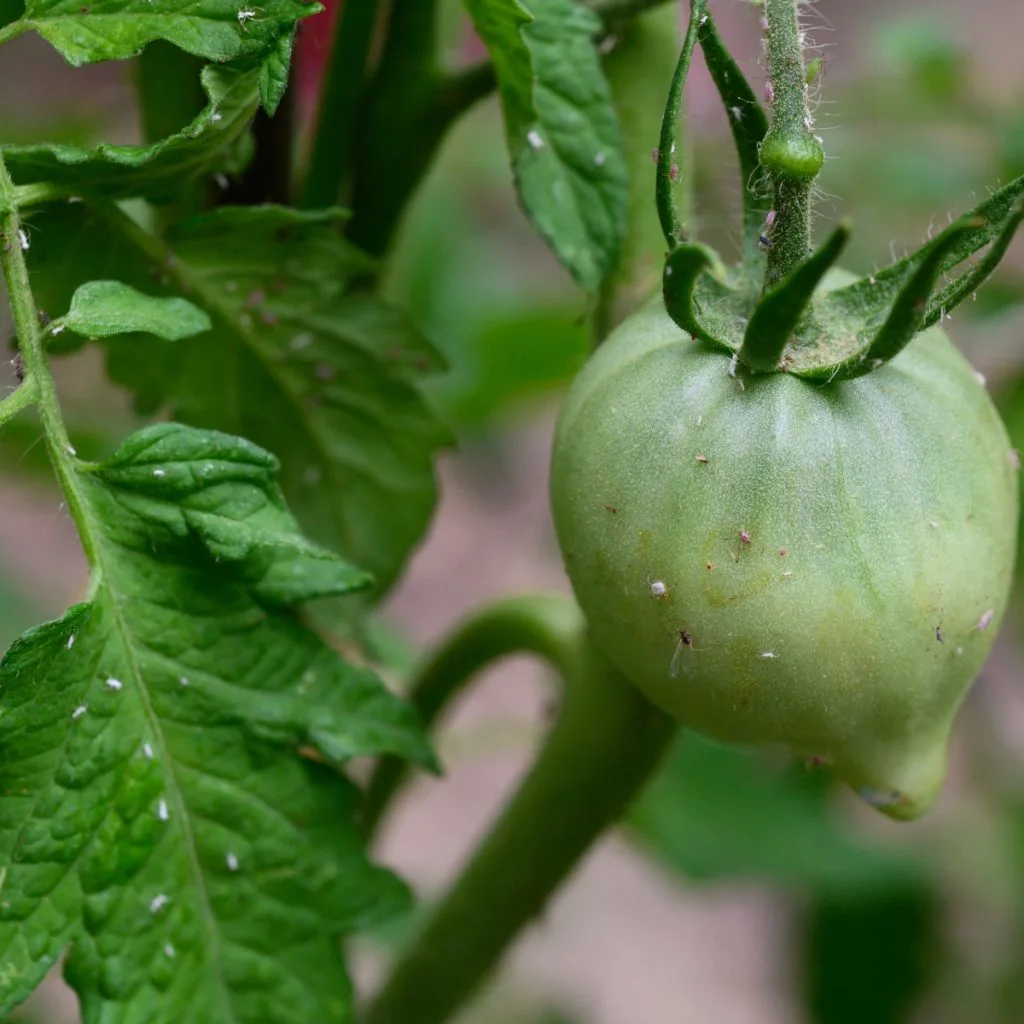Looking for a way to quickly get rid of the aphids on your tomato plants? And keep them off for good?
Aphids might be small insects, but they can cause huge problems in a short amount of time. Especially when it comes to tomato plants. Once they find your plants, they can multiply fast. So fast, in fact, that their numbers can double or even triple in just a few days!
If you don’t catch them early, a small group can turn into a major infestation that damages or even kills your plants. Even worse, aphids don’t stop with tomatoes. If left untreated, they can quickly move to other plants in your garden. And when they do, they can all but decimate an entire garden’s harvest for the year.

The damage aphids leave behind can not only reduce plant growth and hurt fruit production, in some cases, it can even lead to the death of the plant. The good news? You can stop aphids quickly and naturally. Especially if you act early and know just what to do!
How To Quickly Get Rid Of Aphids On Tomato Plants
What Aphids Do To Tomato Plants
Aphids feed by piercing plant leaves and stems and sucking out the sap. This sap is full of nutrients, and when aphids remove it, they rob the plant of important energy needed for growth and fruit development.
As they feed, aphids cause leaves to curl, turn yellow, or become deformed. You may notice that your tomato plant stops growing. In other cases, new leaves that appear look misshapen or weak. In severe cases, the plant may even lose leaves and start to die back.
But that is just from the initial sap loss. What makes aphids worse is that they very often carry viruses and plant disease. So not only can their feeding weaken your tomato plants, they can also spread infection from plant to plant. And once a virus takes hold, there’s usually no way to reverse it. That’s why early detection and action is a must when it comes to aphids.

How To Spot Aphids Early
Since aphids are tiny – often no larger than a pinhead – it can be easy to miss them at first. They often gather on the undersides of leaves, out of sight. That’s why it’s important to look closely when checking your plants.
Flip a few leaves over and see if you can spot any light green, black, yellow, or white insects grouped together. If you see any sticky sap or curling leaves, it usually is a sign they’re already feeding.
Another sign of aphids is an increase in ants around your plants. As aphids feed, they produce a sugary waste called “honeydew,” which ants love to eat. If you see ants crawling up and down your tomato plants, there’s a good chance aphids are nearby.
Honeydew can also leave behind a black, moldy-looking coating on leaves, which can further harm a tomato plant’s health. If you see this or any of the signs above, it’s time to take action quick. And the easiest way to do that is with a quick stream of water!
How To Get Rid Of Aphids With Water
One of the easiest and fastest ways to remove aphids is with a strong spray of water from your garden hose. The water knocks the aphids off the leaves and stems and onto the ground. Once they fall, they usually can’t make their way back to the plant and will die shortly after.

When spraying, make sure to focus on the undersides of the leaves where aphids like to hide. But it’s important to be careful when doing this not to damage your plant. Start with a light spray and adjust the pressure as needed. You may lose a few flowers or small tomatoes, but your plant will recover faster than if the aphids are left alone.
This method works well for light to moderate infestations. For bigger problems, or if aphids return quickly, you’ll want to use more than just water. And the easiest way to do that safely and naturally is with neem oil.
Using Neem Oil
If water alone doesn’t solve the problem, neem oil is an excellent next step. Neem oil is made from the seeds of the neem tree and is completely natural. It’s safe for pets and people and breaks down quickly in sunlight.
When sprayed on plants, neem oil coats the aphids and stops them from feeding and reproducing.To use neem oil on tomato plants, add two tablespoons of neem oil per gallon of water. In addition, squirt in a few drops of dish soap to help the mixture stick to the leaves.
Use a handheld spray bottle or garden sprayer to coat the leaves, especially underneath where the aphids hide. For best results, spray in the early morning or late evening when pollinators are not active. This helps protect helpful insects like bees and butterflies.

To eliminate aphids entirely, reapply the spray every 5 to 7 days until you no longer see any sign of activity or damage. Affiliate Link: HARRIS Neem Oil Cold Pressed Water Soluble Concentrate
A Few Other Ways To Get Rid Of Aphids
Another great way to keep aphid populations in check is by attracting insects that eat them. Ladybugs, lacewings, and parasitic wasps are all natural predators of aphids. These helpful bugs can help manage small infestations before they ever become a serious problem.
The easiest way to attract these beneficial insects is to plant flowers and herbs that offer pollen and nectar. Some great options include:
- Dill
- Fennel
- Yarrow
- Calendula
- Sweet alyssum
- Marigolds
Not only do these plants bring in helpful bugs, but they also add beauty to your garden and even help repel other pests. You can plant them directly in your garden or in pots and place them near your tomato plants.

Use Companion Plants To Repel Aphids
Another smart way to protect your tomato plants is with companion planting. Certain plants naturally repel aphids due to their strong smell or taste. By planting these near your tomatoes, you can keep aphids from ever wanting to visit.
Some great aphid-repelling plants include:
- Mint
- Chives
- Basil
- Cilantro
- Garlic
- Onions
- Marigolds
Plant these close to or between your tomato plants for best results. If you’re short on space, you can grow them in small containers and place them right next to your tomato plants. See our article: The Best Marigolds To Grow To Repel Pests & Attract Pollinators.
Whether it’s spraying them off with water, treating with neem oil, attracting beneficial insects, or planting helpful companion crops, one thing is for sure, a little care goes a long way in helping to get rid of aphids on your tomato plants – for good! For more tips on keeping destructive pests out of the garden, see our article: How To Keep Groundhogs Out Of The Garden – 4 Simple Ways To Stop Groundhogs!
This Is My Garden
Follow Our Facebook Page For Great Gardening Tips And Advice! This Is My Garden Facebook Page
This Is My Garden is a garden website created by gardeners, for gardeners. Jim and Mary Competti have been writing gardening, DIY and recipe articles and books and speaking for over 15 years from their 46 acre Ohio farm. They publish three articles every week, 52 weeks a year. Sign up today to follow via email, or follow along!
